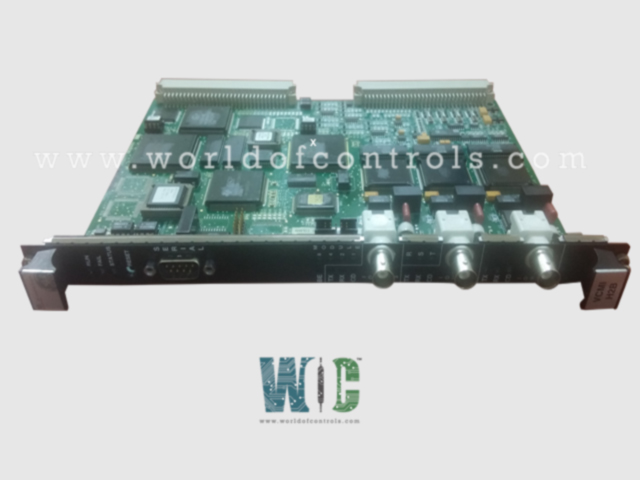
World Of Controls understands the criticality of your requirement and works towards reducing the lead time as much as possible.
IS200VCMIH2BEE - Communication Board is available in stock which ships the same day.
IS200VCMIH2BEE - Communication Board comes in UNUSED as well as REBUILT condition.
To avail our best deals for IS200VCMIH2BEE - Communication Board, contact us and we will get back to you within 24 hours.
Part No.: IS200VCMIH2BEE
Manufacturer: General Electric
Country of Manufacture: United States of America (USA)
Board Type: 6U high VME board, 0.787 inches wide
Processor: TMS320C32
Temperature Operating: -30 to 65oC
Product Type: Communication Board
Availability: In Stock
Series: Mark VI
IS200VCMIH2BEE is a Communication Board developed by GE. It is a part of the Mark VI control system. It links the central controller and the I/O boards within the system architecture, ensuring seamless bidirectional communication. Additionally, it acts as the gateway to the system control network, IONet, facilitating integration into the broader control infrastructure. Responsible for managing data transmission, protocol conversion, fault detection, and synchronization, the VCMI is pivotal in enabling efficient and reliable operation of the industrial control system. Its functions encompass interpreting commands, regulating timing, and ensuring the integrity of data exchange, thereby supporting real-time control and monitoring tasks essential for system performance and reliability.
1. Data Communication and Coordination
It serves as the primary communication interface between the controller and the I/O boards in the Mark VI system. It enables bidirectional communication, ensuring that sensor data, control signals, and feedback are transferred accurately and without delay. This coordination ensures real-time system control and process regulation, which is vital for maintaining operational stability in turbine applications.
2. Protocol Conversion and Data Management
The VCMI board manages protocol translation between various system devices, allowing different hardware components and software layers to communicate effectively. It ensures that all transmitted data complies with GE’s communication standards, enabling seamless integration across both local and distributed system architectures.
3. Fault Detection and System Synchronization
The board continuously monitors communication integrity and performs fault detection routines to identify transmission errors, corrupted data packets, or timing mismatches. It also maintains time synchronization across all connected modules, ensuring that system events are recorded and executed with precise timing—an essential requirement for coordinated turbine control.
Internal Communication
Within the control rack, the VCMI board facilitates internal communication between the central processor and connected I/O boards. This allows high-speed exchange of process data, control commands, and diagnostic feedback, which are crucial for closed-loop control and system diagnostics.
IONet Connectivity
The IONet network forms the backbone of communication within the Mark VI system. It interfaces with this network to connect with other VCMI boards and external control modules. This connectivity supports a distributed architecture, enabling controllers located in different racks or cabinets to operate cohesively as part of a unified system. The IONet also allows for real-time data sharing and redundancy, contributing to improved fault tolerance and scalability.
Ethernet Ports
Depending on the specific configuration, the VCMI board may include one or three Ethernet ports:
Simplex Systems
In simplex configurations, a single control module communicates with one or more I/O interface modules through the VCMI board using a single Ethernet connection. The VCMI manages all data exchanges and synchronization between these components, ensuring smooth and coordinated system operation. This configuration is typically used in systems where redundancy is not a critical requirement.
TMR Systems (Triple Modular Redundancy)
Equipped with three Ethernet ports, it communicates simultaneously with three independent I/O channels — Rx (Receive), Sx (Send), and Tx (Transmit). This architecture enables the system to perform majority voting, where outputs are validated based on consensus among the three channels, significantly enhancing system reliability and fault resilience. Even if one channel experiences a failure, the other two maintain system integrity, ensuring continuous and safe operation.
The WOC team is always available to help you with your Mark VI requirements. For more information, please contact WOC.
What is IS200VCMIH2BEE?
It is a Communication Board developed by GE under the Mark VI series.
What internal power supply buses are monitored, and what are the typical alarm settings?
The internal 5 V, 12 V, 15 V, and 28 V power supply buses are monitored, with alarm thresholds typically set at 3.5 percent for most voltages. However, the 28 V supplies have their alarm thresholds set at 5.5 percent for specific requirements.
What diagnostic signals are monitored from the power distribution module (PDM)?
Diagnostic signals from the PDM, connected through J301, are monitored for ground faults, over/under voltage on the P125 V bus, two differential 5V dc analog inputs, signals for external monitoring circuits (P28A and PCOM), as well as digital inputs.